




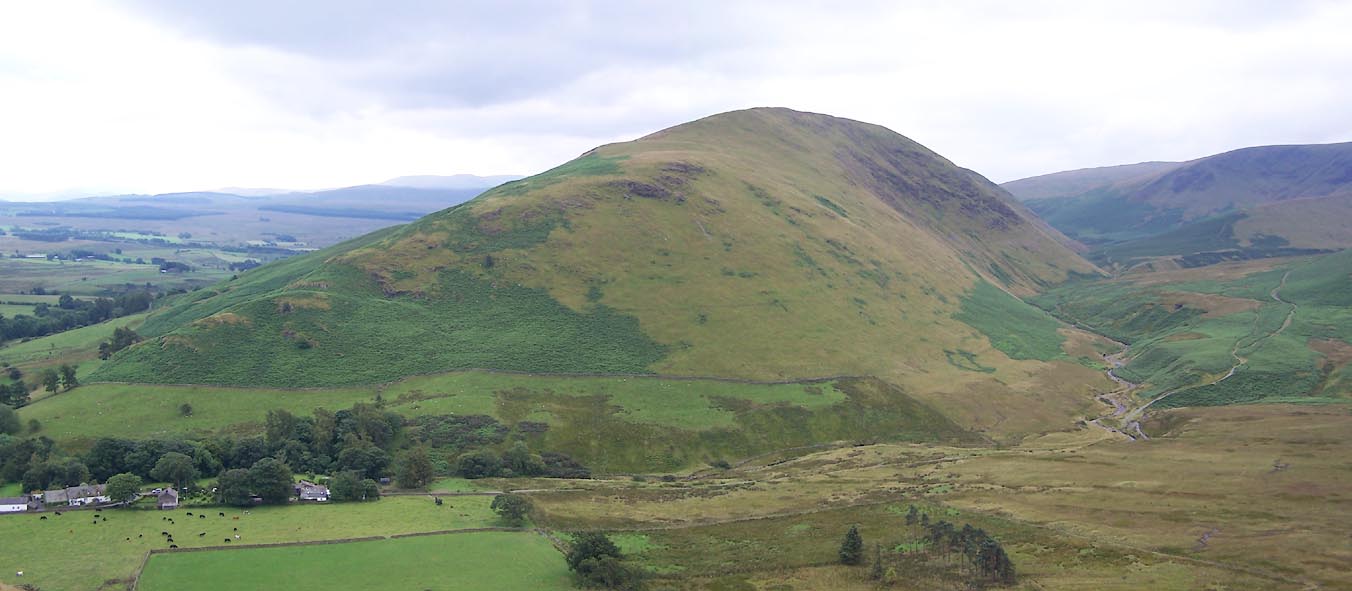
Click to enlarge
BVC91.jpg (taken 3.8.2011)
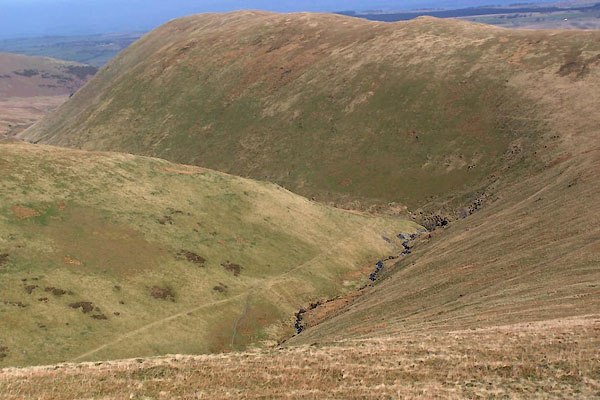
BWD95.jpg and the Gelnderemackin.
(taken 26.3.2012)
placename:- Souther Fell
placename:- Souterfells
item:- spectral army; ghost, Souther Fell
 goto source
goto sourceGentleman's Magazine 1747 p.611 "Downs, Jan. 3, 1748."
"SIR,"
"If you have had no Remarks sent you on the two following subjects, by publishing the observations of a sailor, you may perhaps please some of your readers ashore."
"..."
"II. On the APPARITION at Souterfells, &c. (see Gent. Mag. Nov. 1747."
"HAving observed the learned author's account and suggestion that these strange appearances might be only Meteors, I cannot but remark that our modern men of learning, having ta-"
 goto source
goto sourceGentleman's Magazine 1747 p.612 "[ta]ken it into their heads to imagine there is no hell, at least that its punishments are not eternal, and that the devil, if there is such a being, hath nothing to do with the world; and, consequently, that there can be no such things as spirits. Whenever these immaterial beings are constrained to act in a more open manner than they chuse (for 'tis not th[e] interest of the devil to have it known there is such a being) these wise men are forced either to deny the facts, by accusing the relators of falshood, folly, or credulity, or impute them to other causes. Yet there is an old book, which I shall not name, lest it should be ranked with Glanville, or Amadis de Gaul; for in that old book the Sabeans and Chaldeans could not steal cattle, lightning kill some sheep, a high wind blow down a house, nor a man be troubled with boils, but all is imputed to the Devil; whereas, our modern philosophers would have found a thousand other causes for those misfortunes, in order to excuse that being. Shall I add, that that old book, to give a slight idea of the number of Daemons, asserts, that seven were cast out of one woman, and a legion from a man, &c. But, leaving that old book to itself, let us suppose one of our philosophers to see a regiment of dragoons reviewed in Hyde-Park: If asked what they were? might he not truly answer, that they were a company of spirits, confined for a time to inhabit material bodies of different forms and textures? And was he asked the same question, on sight of a number of animalcules, visible only thro' the assistance of microscopes, would not the same answer be a truth, tho' the bodies of these animalcules are almost as rarified as themselves? Nay, do we not know that there are several insects that change their shapes at times? Where then is the absurdity in supposing it possible for some spirits to appear for a short time in bodies still more refined, and capable of what shape they please, and when? And were this not the case, as who can prove it is not? is not the regularity of a regiment of men's exercise a greater wonder than that of spirits, who may well be supposed much wiser than mortal beings, who are more confined by their bodies than they? In short, if there are really a vast multitude of immaterial beings concerned in the affairs of the world as the said old book seems to assert, is not the denying their existence as great an absurdity as was theirs who denied the antipodes, because they had never seen them? And would not the allowing of such beings be a much easier and truer way to account for such appearances, than that of meteors, &c."
"P. S. It is pleasant to observe, that, notwithstanding the endeavours to discredit the being of spirits, there is hardly a person in England (I believe I may say the world) but hath either heard or seen one himself, or been acquainted with those that have: and was this rightly attended to, such apparitions would be reckoned no more supernatural than it is to see an American or East-Indian; the one being as much a work of creation as the other. But, because spirits are beings something above us, and we cannot account for all their actions, therefore we think there are no such things; but Death shall remove us from our material bodies, when we may perhaps view more fellow spirits than ever we saw fellow-mortals."
"... ..."
placename:- Souter Fell
item:- spectral army; ghost, Souther Fell; meteor
 goto source
goto sourceGentleman's Magazine 1747 p.523 "..."
"Souter-fell is a distinguish'd mountain of itself, encompass'd quite round with a turbinated trough, thro' which the Lender-maken is convey'd. The West and North sides are barricadoed with rocks, the East is more plain but withal steep, and seemingly 900 yards in height, but every where of difficult access. It was on this Fell that the astonishing phaenomenon appear'd to exhibit itself, which in 1735, 1737 and 1745 made so much noise in the North, that I went on purpose to examine the spectators, who asserted the fact, and continue in their assertion very positively to this day."
 goto source
goto sourceGentleman's Magazine 1747 p.524 "On Midsummer eve 1735, Wm Lancaster's servant related that he saw the East side of Souter-fell, towards the top, covered with a regular marching army for above an hour together; he said they consisted of distinct bodies of troops, which appeared to proceed from an eminence in the North end, and march'd over a nitch in the top, [mark'd A and B in my drawing] but as no other person in the neighbourhood had seen the like, he was discredited and laugh'd at. Two years after on Midsummer eve also, betwixt the hours of eight and nine, Wm Lancaster himself imagined that several gentlemen were following their horses at a distance, as if they had been hunting, and taking them for such, pay'd no regard to it, till about ten minutes after, again turning his head towards the place, they appeared to be mounted, and a vast army following, five in rank, crowding over at the same place, where the servant said he saw them two years before. He then call'd his family, who all agreed in the same opinion; and what was most extraordinary, he frequently observed that some one of the five would quit rank, and seem to stand in a fronting posture, as if he was observing and regulating the order of their march, or taking account of the numbers, and after some time appear'd to return full gallop to the station he had left, which they never fail'd to do as often as they quitted their lines, and the figure that did so, was generally one of the middlemost men in the rank. As it grew later, they seem'd more regardless of discipline, and rather had the appearance of people riding from a market, than an army, tho' they continued crowding on, and marching off, as long as they had light to see them."
"This phaenomenon was no more seen 'till the Midsummer eve, which preceded the rebellion, when they were determined to call more families to be witness of this sight, and accordingly went to Wilton-hill and Souter-fell-side, till they conven'd about 26 persons, who all affirm they then saw the same appearance, but not conducted with the usual regularity as the preceding ones, having the likeness of carriages interspersed; however it did not appear to be less real, for some of the company were so affected with it as in the morning to climb the mountain, through an idle expectation of finding horse-shoes, after so numerous an army, but they saw not the vestige or print of a foot."
"Wm Lancaster, indeed, told me that he never concluded they were real beings, because of the impracticability of a march over the precipices, where they seem'd to come on; that the night was extremely serene; that horse and man upon strict looking at appear'd to be but one being, rather than two distinct ones; they were nothing like any clouds or vapours, which he had ever perceiv'd elsewhere; that their number was incredible, for they fill'd lengthways near half a mile, and continued so in a swift march for above an hour, and much longer he thinks if night had kept off."
"This whole story has so much the air of a romance, that it seem'd fitter for Amadis de Gaul, or Glanville's system of Witches, than the repository of the learned; but as the country was full of it, I only give a verbatim from the original relation of a people, that could have no end in imposing on their fellow-creatures, and are of good repute in the place where they live."
"It is my real opinion, that they apprehended they saw such appearances, but how an undulating lambent meteor could affect the optics of so many people is difficult to say. No doubt fancy will extend to miraculous heights in persons dispos'd to indulge it; and whether there might not be a concurrence of that, to assist the vapour, I will not dispute, because three difficulties seem to occur, worthy of solution † "
"1st, Why a lambent agitated meteor should appear to stop at certain intervals, and return with augmented velocity to reassume the forsaken place."
"2d, Why it should for a very long time preserve so regular a system, as to appear still five in a line."
"3d. Why one particular evening in the year, only, exhibited the unusual meteor for three times, at so long intervals."
"As these are at present beyond my philosophy to explain, it may be an amusement to such as will give themselves the trouble of enquiry, having neither added nor diminished to the"
" †To this relation we may add that in the spring of the year 1707, early in a serene still morning, was observed by two persons, one of the name of Churchill, who were walking from one village to another in Leicestershire, a like appearance of an army marching along, till going behind a great hill, it disappeared.- The forms of pikes and carbines were distinguishable, the march was not entirely in one direction, but was at the first like the junction of two armies, and the meeting of generals."
 goto source
goto sourceGentleman's Magazine 1747 p.525 "accounts given me. Those who treat it as a mere illusion or deceptio visus, should assign reasons for so large a fascination in above 20 persons; probably one, indeed, might serve to aggrandize the fancy of others, but I should think they could not be so universally deceiv'd without some stamina of the likeness exhibited on the mountain from a meteor, or some unknown cause."
"It is singularly remarkable, that most of all these mountains have their precipices fronting the West and Northwest, which is a strong collateral proof of the Earth's motion, because the diurnal revolution would naturally throw off all the loose strata in its fluid state to the opposite quarter, and the concurring suffrage of travellers in the same properties of foreign mountains, where reasons are not obvious for their being otherwise, much strengthens the argument."
"..."
placename:- Suterfell Mount
Image from a plate opposite p.524.
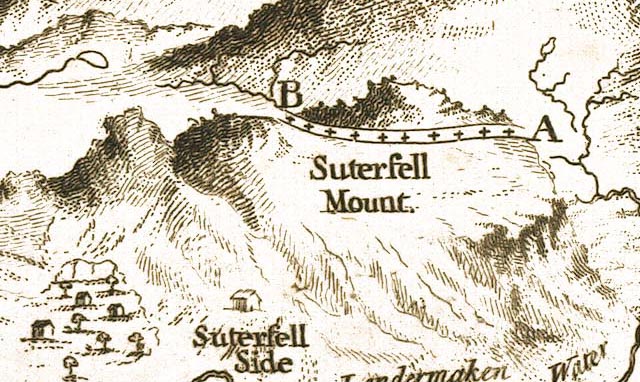
GM1402.jpg
"Suterfell Mount."
knobbly hillocks; mountains; a double line, marked with crosses (+) from A to B marks a route
item:- Carlisle Library : Map 43
Image © Carlisle Library
placename:- Souther Fell
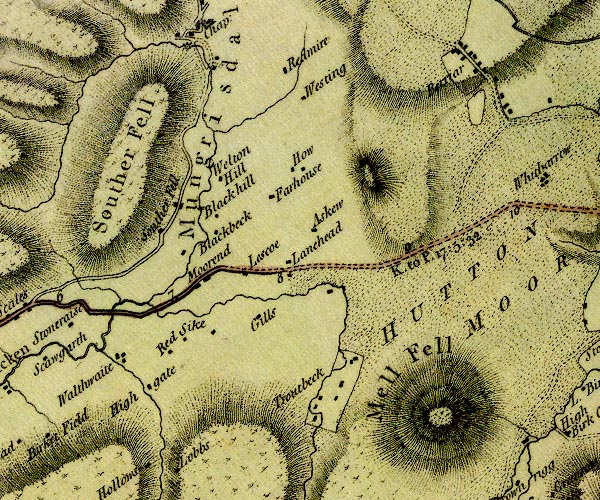
D4NY32NE.jpg
"Souther Fell"
hill hachuring; a hill or mountain
item:- Carlisle Library : Map 2
Image © Carlisle Library
placename:- Southerfell
item:- ghost; soldier
 goto source
goto sourcePage 55:- "..."
"Opposite the nine-mile post, on the right hand, is Southerfell; rather smoother than its neighbours, and remarkable for an extraordinary phaenomenon, which perhaps can scarcely be paralleled by history, or reconciled to probability: such, however, is the evidence we have of it, that I cannot help relating it, and then my readers must judge for themselves. I shall give it nearly in the words of Mr Lancaster of Blakehills, from whom I had the account; and whose veracity, even were it not supported by many concurrent testimonies, I could fully rely upon. The story is as follows:"
"On the 23d of June 1744, his father's servant, Daniel Stricket, (who now lives under Skiddow, and is an auctioneer,) about half past seven in the evening was walking a little above the house. Looking round him, he saw a troop of men on horseback riding on Southerfell-side, (a place so steep that an horse can scarcely travel on it at all,) in pretty close ranks, and at a brisk walk. Stricket looked earnestly at them some time before he durst venture to acquaint any one with what he saw, as he had the year before made himself ridiculous by a visionary story, which I beg leave here also to relate: He was at that time servant to John Wren of Wilton-hill, the next house to Blakehills, and sitting one evening after supper at the door along with his master, they saw a man with a dog pursuing some horses along Southerfell-side; and they seemed to run at an amazing pace, till they got out of sight at the low end of the Fell. This made them resolve to go next morning to the place to pick up the shoes which they thought these horses must have lost in galloping at such a furious rate; they expected likewise to see prodigious grazes from the feet of these horses on the steep side of the mountain, and to find the man lying dead, as they were sure he run so fast that he must kill himself. Accordingly they went, but, to their great surprise, found not a shoe, nor even a single vestige of any horse having been there, so much less did they find the man lying dead as they expected. This story they some time concealed; at length, however, they ventured to tell it, and were, (as might be expected) heartily laughed at. Stricket, conscious of his former ridiculous error, observed these aerial troops some time before he ventured to mention what he saw: at length, fully satisfied that what he saw was real, he"
 goto source
goto sourcePage 56:- "went into the house, and told Mr Lancaster he had something curious to shew him. Mr Lancaster asked what it was, adding, "I suppose some bonefire," (for it was then, and still is a custom, for the shepherds, on the evening before St John's day, to light bonefires, and vie with each other in having the largest.) Stricket told him, if he would walk with him to the end of the house he would shew him what it was. They then went together, and before Stricket spoke or pointed to the place, Mr Lancaster himself discovered the phaenomenon, and said to Stricket: "Is that what thou hast to shew me?" "Yes. Master," replied Stricket: "Do you think you see as I do?" They found they did see alike, so they went and alarmed the family, who all came, and all saw this strange phaenomenon."
 goto source
goto sourcePage 56:- "These visionary horsemen seemed to come from the lowest part of Souther-Fell, and became visible first at a place called KNOTT; they then moved in regular troops along the side of the Fell, till they came opposite Blake-hills, when they went over the mountain: thus they described a sort of curvilineal path upon the side of the Fell, and both their first and last appearance were bounded by the top of the mountain."
"Frequently the last, or last but one, in a troop, (always either the one or the other,) would leave his place, gallop to the front, and then take the same pace with the rest, a regular, swift walk: these changes happened to every troop, (for many troops appeared,) and oftener than once or twice, yet not at all times alike. The spectators saw, all alike, the same changes, and at the same time as they discovered, by asking each other questions as any changes took place. Nor was this wonderful phaenomenon seen at Blake-hills only, it was seen by every person at every cottage within the distance of a mile; neither was it confined to a momentary view, for from the time that Stricket first observed it, the appearance must have lasted at least two hours and an half, viz. from half past seven, till the night coming on prevented the farther view; nor yet was the distance such as could impose rude resemblances on the eyes of credulity: Blake-hills lay not half a mile from the place where this astonishing appearance seemed to be, and many other places where it was likewise seen are still nearer."
"Desirous of giving my readers every possible satisfaction, I procured the following attestation, signed by Mr Lancaster and Stricket:"We whose names are hereunto subscribed, decare the above account to be true, and that we saw the phaenomena as here related. As witness our hands this 21st day of July 1785.
WILLIAM LANCASTER
DANIEL STRICKET.""
"Thus I have given the best account of this wonderful appearance; let others determine what it was. This country, like every other where cultivation has been lately introduced, abounds in the aniles fabellae of fairies, ghosts, and apparitions; but these are never even fabled to have been seen by more than one or two persons at a time, and the view is always said to be momentary. Speed tells of something indeed similar to this as preceding a dreadful intestine war. Can something of this nature have given rise to Ossian's grand and awful mythology? or, finally, Is there any impiety in supposing, as this happened immediately before that rebellion which was intended to subvert the liberty, the law, and the religion of England; that though immediate prophecies have ceased, these visionary beings might be directed to warn mankind of approaching tumults? In short, it is difficult to say what it was, or what it was not."
placename:- Southerfell
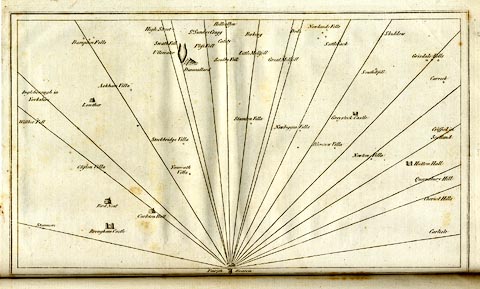 click to enlarge
click to enlargeCL18.jpg
"Southerfell"
item:- Armitt Library : A6615.12
Image © see bottom of page
placename:- Souter Fell
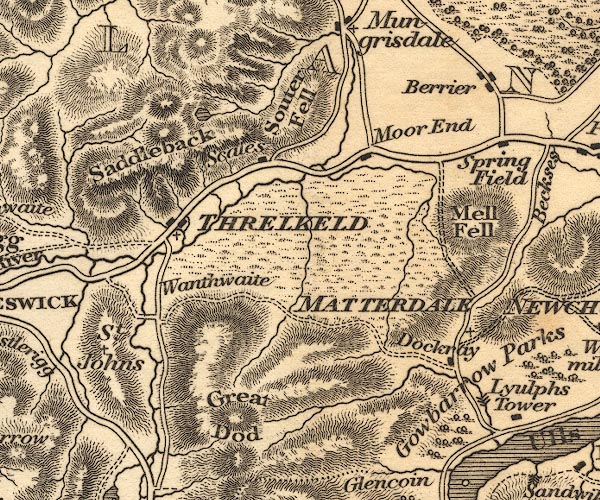
OT02NY32.jpg
item:- JandMN : 48.1
Image © see bottom of page
placename:- Sour Milk Force
item:- height, Sour Milk Gill
 goto source
goto sourcePage 179:- "WATERFALLS."
| No. | Name and Situation of Fall. | Height. |
| 7 | Sour Milk Force |
 goto source
goto sourcePage 94:- "..."
"... Souter fell has acquired some notoriety as having been the scene of meteorological appearances, which were observed some considerable time back. ..."
placename:- Souter Fell
placename:- Souter Fell
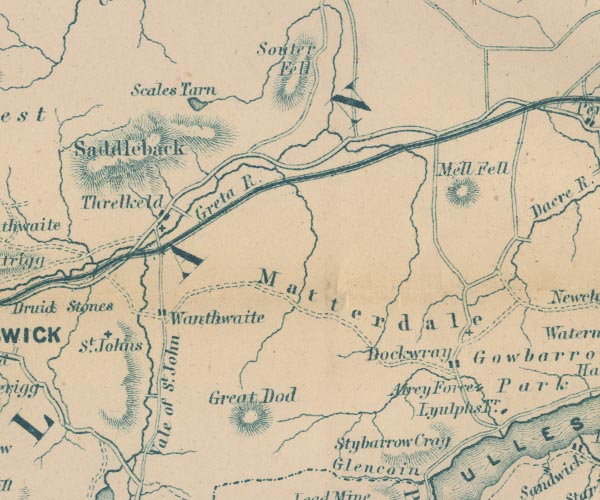
GAR2NY32.jpg
"Souter Fell"
hill hachuring
item:- JandMN : 82.1
Image © see bottom of page
placename:- Souter Fell
placename:- Soutra Fell
item:- ghost story; ghost
 goto source
goto sourcePage 96:- "... The hill-side path is to be taken which leads along Souter Fell, by the side of the stream which descends from Scales tarn. This part is the very home of superstition and romance. This Souter, or Soutra"
 goto source
goto sourcePage 97:- "Fell, is the mountain on which ghosts appeared in myriads, at intervals during ten years of the last century,- presenting precisely the same appearances to twenty-six chosen witnesses, and to all the inhabitants of all the cottages within view of the mountain; and for a space of two hours and a-half at one time - the spectral show being then closed by darkness. The mountain is full of precipices which defy all marching of bodies of men; and the north and west sides present a sheer perpendicular of 900 feet. On Midsummer eve 1735, a farm-servant of Mr. Lancaster's, half-a-mile from the mountain, saw the eastern side of the summit covered with troops, which pursued their onward march for an hour. They came, in distinct bodies, from an eminence in the north end, and disappeared in a niche in the summit. When the poor fellow told this tale, he was insulted on all hands; as original observers usually are when they see anything wonderful. Two years after, also on a Midsummer eve, Mr. Lancaster saw some men there, apparently following their horses, as if they had returned from hunting. He thought nothing of this; but he happened to look up again ten minutes after, and saw the figures now mounted, and followed by an interminable array of troops, five abreast, marching from the eminence and over the cleft, as before. All the family saw this, and the manoeuvres of the force, as each company was kept in order by a mounted officer who galloped this way and that. As the shades of twilight came on, the discipline appeared to relax, and the troops intermingled, and rode at unequal paces, till all was lost in darkness. Now, of course, all the"
 goto source
goto sourcePage 98:- "Lancasters were insulted, as their servant had been: but their justification was not long delayed. On the Midsummer eve of the fearful 1745, twenty-six persons, expressly summoned by the family, saw all that had been seen before, and more. Carriages were now interspersed with the troops; and every body knew that no carriages ever had been, or could be, on the summit of Souter Fell. The multitude was beyond imagination; for the troops filled a space of half-a-mile, and marched quickly till night hid them,- still marching. There was nothing vaporous or indistinct about the appearance of these spectres. So real did they seem that some of the people went up, the next morning, to look for the hoof-marks of the horses; and awful it was to them to find not one foot-print on heather or grass. The witnesses attested the whole story on oath before a magistrate; and fearful were the expectations held by the whole country-side about the coming events of the Scotch rebellion. It now came out that two other persons had seen something of the sort in the interval, viz., in 1743,- but had concealed it to escape the insults to which their neighbours were subjected. Mr. Wren, of Wilton Hall, and his farm-servant, saw, one summer evening, a man and a dog on the mountain, pursuing some horses along a place so steep that a horse could hardly, by any possibility, keep a footing on it. Their speed was prodigious, and their disappearance at the south end of the fell so rapid, that Mr. Wren and the servant went up, the next morning, to find the body of the man who must have been killed. Of man, horse, or dog, they found not a trace: and they came"
 goto source
goto sourcePage 99:- "down, and held their tongues. When they did speak, they fared not much the better for having twenty-six sworn comrades in their disgrace. As for the explanation,- the Editor of the Lonsdale Magazine declared (Vol.ii. p.313.) that it was discovered that on that Midsummer eve of 1745, the rebels were "exercising on the western coast of Scotland, whose movements had been reflected by some transparent vapour, similar to the Fata Morgana." This is not much in the way of explanation: but it is, as far as we know, all that can be had at present. The facts, however, brought out a good many more; as the spectral march of the same kind seen in Leicestershire in 1707: and the tradition of the tramp of armies over Helvellyn, on the eve of the battle of Marston Moor. And now the tourist may proceed, - looking for ghosts, if he pleases, on Souter Fell."
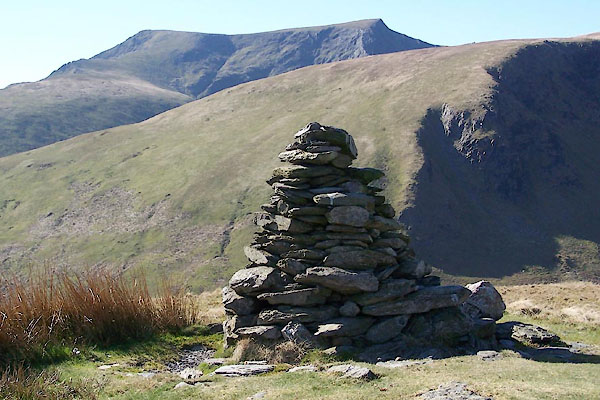
BWE03.jpg A cairn,
(taken 26.3.2012)
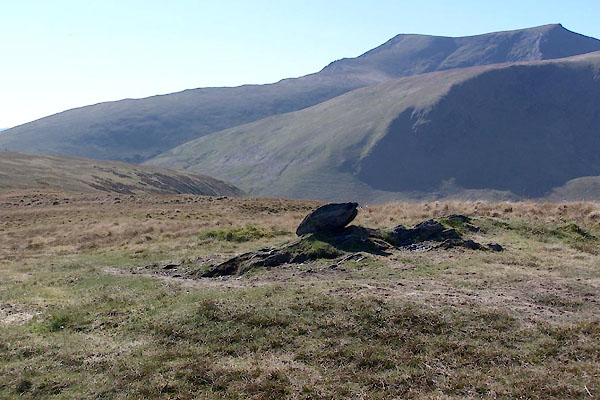
BWE04.jpg Summit, ?cairn.
(taken 26.3.2012)
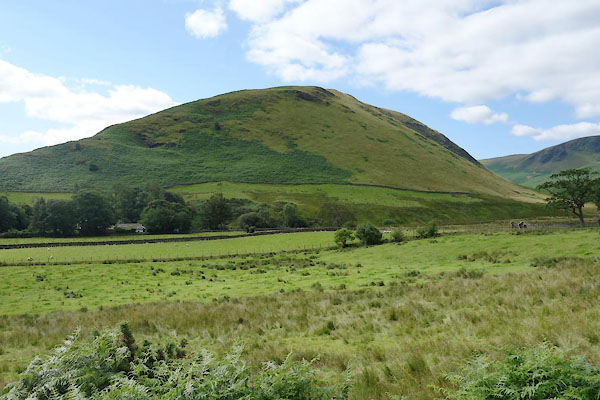
CDR24.jpg From Mungrisdale.
(taken 12.8.2015)
